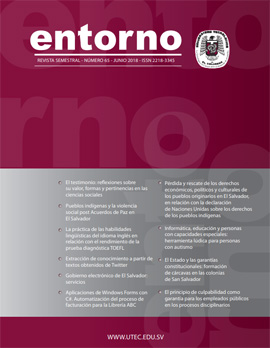Published 2018-06-01
Keywords
- Lenguajes de procesamiento de texto,
- Archivos de texto,
- Visualización de la información,
- Recuperación de información,
- Sistemas de almacenamiento y recuperación de información
- Tecnología de las comunicaciones,
- Telecomunicaciones ...More
Copyright (c) 2018 Ronny Adalberto Cortez Reyes

This work is licensed under a Creative Commons Attribution-NonCommercial-ShareAlike 4.0 International License.
How to Cite
Abstract
The objective of “Extraction of knowledge from texts obtained from Twitter“ is to apply data mining techniques to a set of tweets, in order to extract information to be able to find out what people are talking about and thus generate ideas or concepts, with the use of a variety of graphic representations.
A set of tweets generated between January 1 and February 21, 2018 has been used to conduct this analysis, and the topic is related to artificial intelligence. The process was divided in three main phases: tweets collection, text processing and display of results.
The use of a variety of graphs facilitated the presentation of comprehensible data for the reader; this allowed them to have an idea on the concepts being expressed in the texts and the selection of the main ideas.
URI: http://hdl.handle.net/11298/451
DOI: https://doi.org/10.5377/entorno.v0i65.6048
References
- Contreras Barrera, M. (2014). Minería de texto: una visión actual. Recuperado de http://www.redalyc.org/pdf/285/28540279005.pdf
- Das, S. R. (2017). Data science: theories, models, algorithms, and analytics. Recuperado de http://srdas.github.io/MLBook/TextAnalytics.html#term-document-matrix-tdm
- Gurusamy, V., & Kannan, S. (2014). Preprocessing Techniques for Text Mining. Recuperado de https://www.researchgate.net/publication/273127322_Preprocessing_Techniques_for_ Text_Mining
- IBM. (s. f.). About Text Mining. Recuperado de https://www.ibm.com/support/knowledgecenter/es/SS3RA7_16.0.0/com.ibm.spss.ta.help/textmining/_shared_entities/tm _intro_tm_defined.htm
- Mining Online. (2014). Dive into nltk, part IV: stemming and lemmatization. Recuperado de http://textminingonline.com/dive-into-nltk-part-iv-stemming-and-lemmatization
- Moujahid, A. (2014). An introduction to text mining using twitter streaming api and python. Recuperado de http://adilmoujahid.com/posts/2014/07/twitter-analytics/
- Murphy, J., & Roser, M. (2018). Internet. Recuperado de https://ourworldindata.org/internet
- Raulji, J., & Saini, J. (2016). Stop-Word Removal Algorithm and its Implementation for Sanskrit Language. International Journal of Computer Applications. 150(2), 15-17. Recuperado de http://www.ijcaonline.org/archives/volume150/number2/raulji-2016-ijca- 911462.pdf
- Rochina, P. (2017). ¿Qué es el Text Mining?. Revista digital inesem. Recuperado de https://revistadigital.inesem.es/informatica-y-tics/text-mining/
- Rodríguez Blanco, A., Cuevas, S., & J, A. (2013). Método para la extracción de información estructurada desde textos.Revista Cubana de Ciencias Informáticas. 7(1), 55-67.
- Sancho Caparrini, F. (2017). Introducción al aprendizaje automático. Recuperado de http://www.cs.us.es/~fsancho /?e=75Text
